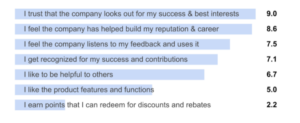Shift from Paid Customer Advocacy to Earned Customer Advocacy – Part 1
If you go to TripAdvisor to check out a vacation resort, and you know the resort paid its guests or offered free spa services to get them to write 5 star reviews, how much trust do you put in those reviews?
If you’re recruiting for a key position find out one of your candidates paid his connections or gave them Capital Grille gift cards to write LinkedIn recommendations for him, how much weight would you put on those recommendations?
Not a lot. Why? Because the trust is broken.
So why is it OK for B2B companies to reward customers to write reviews on G2Crowd, agree to a case study, take reference calls, or speak at events? Do you assume your buyers are naive enough to believe these sponsored stories anyway?
I confess, I did it for years. I ran customer reference programs, user groups, and customer advisory boards. I got customers to do case studies, talk to industry analysts, and give testimonials.
And thinking that customers wouldn’t play unless they were bribed, I always resorted to offering incentives in exchange for their favors. In the on-premise software days, I gave them discounts on their maintenance fees or free training. In SaaS it was free upgrades to premium services, $200 Amazon gift cards, or donations in their name to their favorite charities.
A pattern emerged when I used rewards to incent customers to do acts of advocacy. The customer would do only what I asked her to do – no more or no less – in order to get the reward. He’d wait until the next reward was offered before he’d consider doing something else.
I felt like I was still house-training my puppy. “Good boy, Benny. Good boy for going outside to pee, here’s your treat.”
Dan Ariely, professor of Psychology and Behavioral Economics at Duke University, wrote about this in his book Predictably Irrational. He says we live in two worlds: the world of Social Norms and the world of Market Norms, but we can only operate in one of those worlds at a time.
If someone offers to pay us to do something, we evaluate it based on Market Norms…is the reward being offered fair for what I’m being asked to do? But when we’re asked to do something with no reward, Social Norms guide us, and we think about our relationship with the person or organization, our own reputation, what we think of ourselves, and what we want others to think of us.
What would you think if a friend offered to pay you $50 to drive him to the airport?
When I set out to build a global customer voice/engagement program at Forrester, I almost fell into the Market Norms trap all over again. I thought, “what if I offer customers a free event ticket, or a free strategy session with an analyst, in exchange for them inviting peers to our webinars or talking about how Forrester helped with their initiatives?”
Luckily, something one of Forrester’s top digital marketing analysts, Sean Corcoran, wrote in 2009 stuck in my brain. He penned this blog post – Defining Earned, Owned And Paid Media. Sean defined the three terms as:
- Owned Media: a channel the brand controls
- Paid Media: a brand pays to leverage a channel
- Earned Media: when customers become the channel
Marketers love earned media because we can spend less on advertising. While Sean didn’t suggest we eliminate owned and paid media, his advice is to plan and execute your owned and paid media to make it a catalyst to drive more engagement and earned media.
I realized this distinction between paid versus earned also applies to customer advocacy, and getting my clients to do the specific acts of advocacy I was trying to mobilize at Forrester – having them share their experiences and value realized from working with the company. So I distinguish between paid and earned customer advocacy like this:
- Paid Customer Advocacy: a brand pays or rewards its customers to do favors for the brand
- Earned Customer Advocacy: a brand engages customers in a two-way exchange of value
Unfortunately, the idea of paying or otherwise rewarding customers for doing case studies, speaking engagements, product reviews, and reference calls is so entrenched in the DNA of B2B companies that people won’t even consider that there’s another way. So in early 2015, when I was testing the market for my new concept that became SlapFive, I set out to prove it.
I surveyed 163 executives who purchase business technology and manage vendor relationships. I asked them one question:
What would motivate you to advocate for a company you do business with?
Notice that the top five factors are Social Norms that get crushed if you offer rewards. They support Earned Customer Advocacy, because they are a two-way exchange of value. When a customer feels like you’ve made them successful, the power of reciprocity kicks in and they want to make you successful.
Even more importantly, notice what’s at the bottom of the list…a factor that’s a Market Norm, or Paid Customer Advocacy.
Since this was a multiple choice question, and “Other” was an option, people always ask what were the write-in candidates, so to satisfy curious minds, they fell into these buckets:
- I know the owners/executives of the company, or a friend or relative who works there
- I feel like a company insider
- To influence the vendor’s product direction
- It’s good to be associated with their brand
- They give me Red Sox tickets. (Insert your favorite sports team)
I didn’t stop there. I then took my findings and concept to a bunch of ridiculously smart people I view as thought leaders in B2B marketing, sales, and customer experience. In my next post, I’ll share what they had to say. I’ll also show you a model for Earned Customer Advocacy and highlight how it contrasts with Paid Customer Advocacy.
But first, fire away. If you think Earned Customer Advocacy is a no-brainer, post a comment with what you’re doing. If you think that Earned Customer Advocacy would never work in your business, tell me why, and you won’t be alone because I have people tell me that every day.


